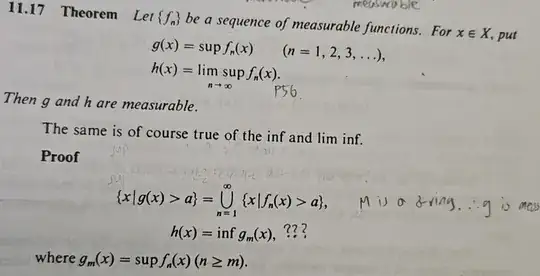I'm studying analysis with Principles of Mathematical Analysis written by Walter Rudin.
In the proof of 11.7 Theorem, I don't understand how it can be proven that h is measurable.
I understand the first part of the proof which proves that g is measurable.
However, I can't follow how $h(x)$ is equal to $\inf g_{m}(x)$.
In the definition of $h(x)$ in the 11.7 Theorem, $h(x)$ is equal to $\limsup\limits_{n\rightarrow\infty} f_{n}(x)$.
Why is $\limsup\limits_{n\rightarrow\infty} f_{n}(x)$ equal to $\inf g_{m}(x)$?
Can anyone explain the relationship between $\limsup$ and $\inf$ in this case?
In addition, I don't understand how $g_{m}(x)$ is equal to $\sup f_{n}(x) (n\geq m).$
Especially, I suspect that $\sup f_{n}(x) (n\geq m)$ is misprinting and It should be $\sup f_{\bf{m}}(x) (n\geq m)$.
Should the $n$ at the last line of the proof be changed to $m$?
